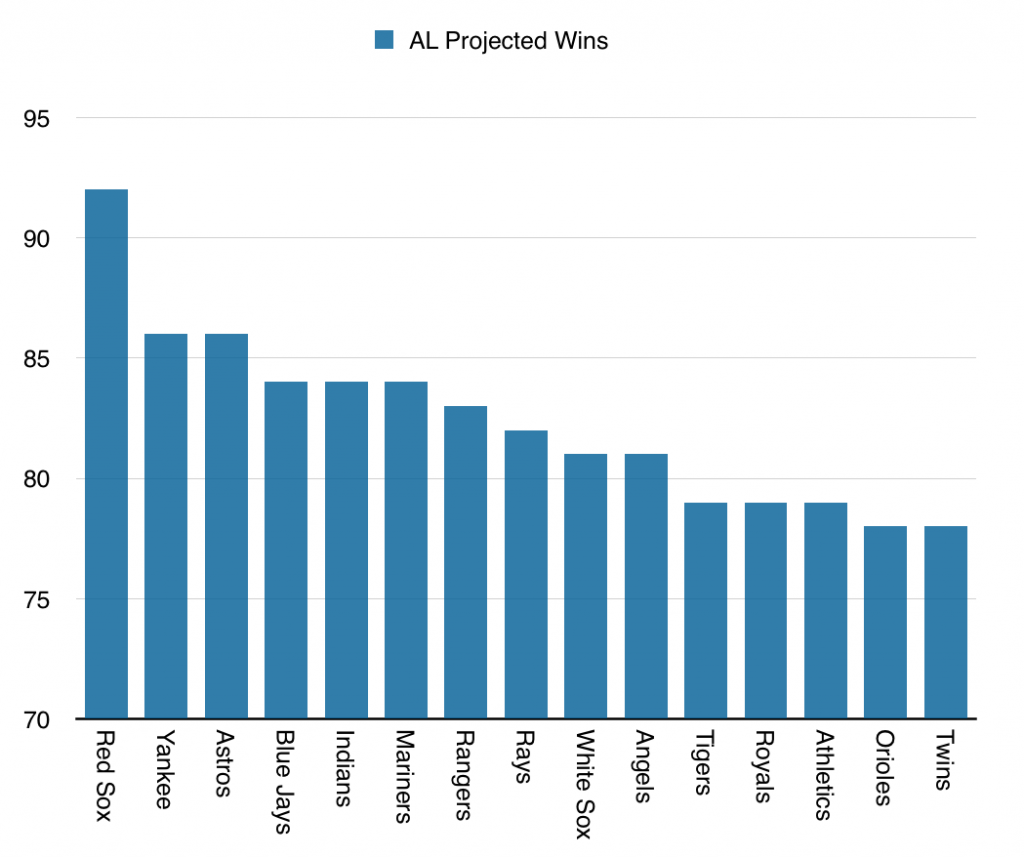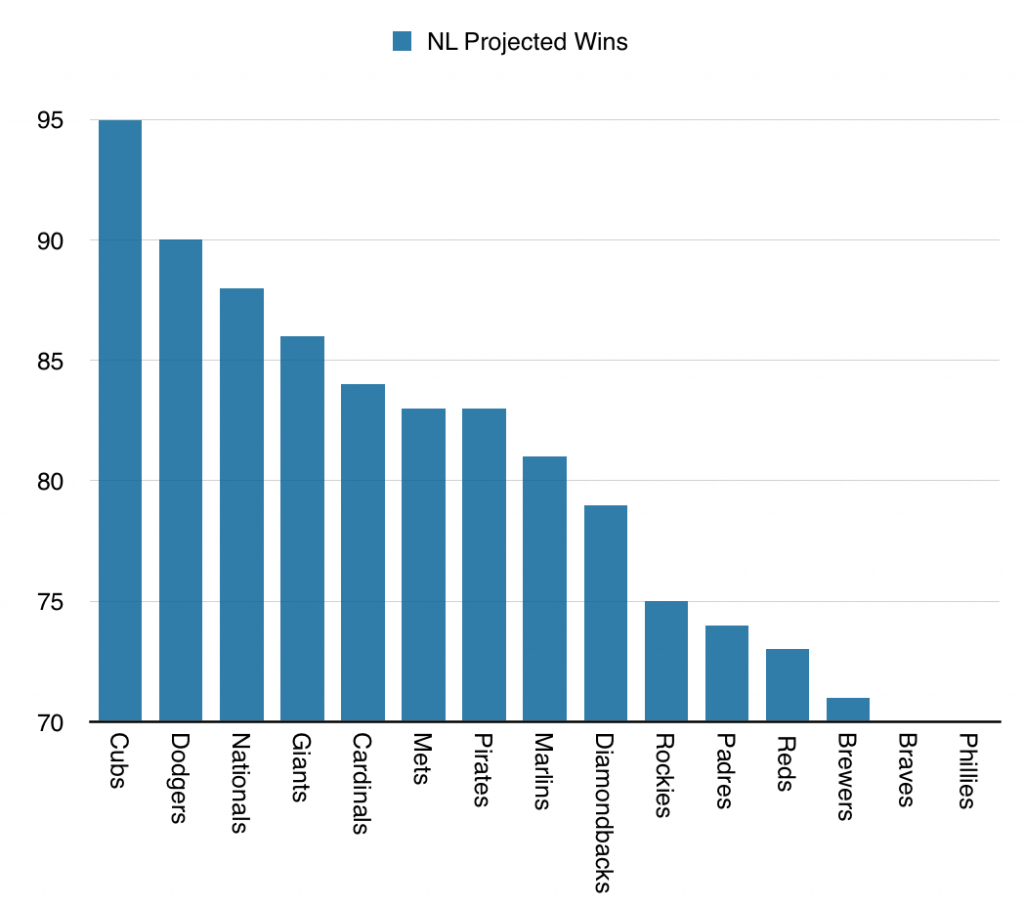Can the Diamondbacks Take Advantage of a Weak National League?
There’s a weird disparity in baseball right now. Jason Stark profiled it well for ESPN last week. In the American League, there are few, if any, teams that have no chance to compete. Using Fangraphs’ projected standings based off Steamer projections, there is no team predicted to win fewer than 78 games. Ten of the 15 teams are projected for .500 or better records. By contrast, the National League has six teams projected to win less than 78 wins and only eight teams are projected for .500 or better records. By that measure, the AL would stand to be more competitive overall than the NL.
But that doesn’t show us the magnitude of this disparity. Maybe the charts below will.
The curve is obviously much steeper in the National League. The Braves and Phillies don’t even make the meet the 70-win threshold. The sixth-worst team in the NL, the Rockies, finally reaches the 75-win mark while the sixth-worst team in the AL, the Angels, are right at the .500 threshold at 81-81. These are clearly different pictures, and although there is some interleague play, the National League has a huge high-low disparity compared to the American League.
I bring all of this up because the Diamondbacks are going to play a lot more games against National League opponents than American League opponents in 2016 as per usual. The imbalance between leagues could have a major impact on the number of D-backs wins in this season. If we look ahead at the schedule, we see the team has 18 games against the Rockies and 18 against the Padres. To add some icing to the cake, the team has 27 combined games against the Braves, Brewers, Phillies and Reds. That’s 63 of the team’s 162 against the bottom of the National League.
The D-backs aren’t alone here. Other National League contenders will have a similar situation on their hands. But the discrepancy here could have major ramifications on team records. Never before have we seen so many doormats… er, rebuilding teams, in one league. From Stark:
Now obviously, with the projection business being the imprecise mess that it always is, the chances that it all plays out that way are somewhere in the vicinity of, oh, zero. But let’s assume it’s at least close, because it’s not unreasonable. Then these would be the two most significant takeaways:
1. It would be the first season ever, since the formation of the American League in 1901, that the six teams with the worst records in baseball would all come from one league.
2. Even more significantly, it would mean that only nine teams — at most — are fighting for five playoff spots in the NL. And it’s hard to beat those odds.
There has been criticism of the situation and it has stemmed from two areas:
1. People aren’t sold on the projections and I get that. We had that discussion here already. Predicting the number of wins is a super imprecise science – one that takes a million things into considerations and only gets us close. Like I said in the piece I wrote last week, it serves best as a sort of benchmark or shorthand for predicting the pecking order in baseball. Surely there aren’t 13 teams that will finish within two games of .500, but there are probably 13 teams who are roughly .500 clubs based on talent and a little bit of luck (or unluck). You get the idea.
2. People aren’t sold that all of these team, the Brewers and Reds and Braves and Phillies and Padres and Rockies, are rebuilding. Those last two are especially hard to label as rebuilding franchises, especially considering the Padres went for broke and, well, ended up broke. Meanwhile, the Rockies are in the worst place to be – no man’s land. They’re not bad enough to really commit to a rebuild (unless they do eventually ship off Carlos Gonzalez) but not good enough to play meaningful baseball. The whole Coors Field things wreaks havoc on their situation, too, and they’ve never found a true winning formula there, although ownership and leadership have had a big hand in that, too.
The Brewers sound committed to rebuilding based on the words of new GM David Stearns. The Phillies are finally taking a new approach post-Ruben Amaro. The pieces they got from the Rangers for Cole Hamels certainly have them pointed to a more inspiring future after they held on to their contention window a few seasons too long. The Reds seem content to waste the remaining good years of Joey Votto while they try to remake themselves, although I’d expect a different strategy than that employed by Milwaukee and Philadelphia. The Braves are looking to rebuild around Freddie Freeman, with a large helping hand from Arizona, just in time for their new ballpark to open in 2017. Aaron Blair, Dansby Swanson and Ender Inciarte could all log time for Atlanta in the debut season of their new digs. These teams are clearly rebuilding themselves in my eyes.
The Diamondbacks, along with all of the NL contenders, will have to be opportunistic and take advantage of this effect. It stands to reason that if the team were even close to .500 against all other competition, they could inflate their record by dominating this weaker competition. If they won, say, 40 of those 63 games against the six bottom teams in the NL, they might be able to pull off something like an 88-win season. Maybe 90. But one has to wonder, what will the Dodgers and Nationals and Cubs’ records look like? It’s not as if Arizona is the only team that will face this disparity. Maybe it takes 90+ wins in the end just make a Wild Card appearance.
It’s hard to prognosticate this effect, but it should be on your radar. The team still has unfinished business and is a fringy contender as it stands now. There are probably six teams that are better than them on paper. The game’s not played on paper, but you get the point. Taking advantage of this weird, historic disparity might be the difference between getting in and sitting at home come October. The rest of the NL is going to be tough, but holding serve against the haves and cleaning up against the have-nots could be what it takes.
4 Responses to Can the Diamondbacks Take Advantage of a Weak National League?
Leave a Reply Cancel reply
Recent Posts
@ryanpmorrison
 Congrats to @OutfieldGrass24 on a beautiful life, wedding and wife. He deserves all of it (they both do). And I cou… https://t.co/JzJtQ7TgdJ, Jul 23
Congrats to @OutfieldGrass24 on a beautiful life, wedding and wife. He deserves all of it (they both do). And I cou… https://t.co/JzJtQ7TgdJ, Jul 23 Best part of Peralta’s 108 mph fliner over the fence, IMHO: that he got that much leverage despite scooping it out… https://t.co/ivBrl76adF, Apr 08
Best part of Peralta’s 108 mph fliner over the fence, IMHO: that he got that much leverage despite scooping it out… https://t.co/ivBrl76adF, Apr 08 RT @OutfieldGrass24: If you're bored of watching Patrick Corbin get dudes out, you can check out my latest for @TheAthleticAZ. https://t.co/k1DymgY7zO, Apr 04
RT @OutfieldGrass24: If you're bored of watching Patrick Corbin get dudes out, you can check out my latest for @TheAthleticAZ. https://t.co/k1DymgY7zO, Apr 04 Of course, they may have overtaken the league lead for outs on the bases just now, also...
But in 2017, Arizona ha… https://t.co/38MBrr2D4b, Apr 04
Of course, they may have overtaken the league lead for outs on the bases just now, also...
But in 2017, Arizona ha… https://t.co/38MBrr2D4b, Apr 04 Prior to the games today, there had only been 5 steals of 3rd this season (and no CS) in the National League. The… https://t.co/gVVL84vPQ5, Apr 04
Prior to the games today, there had only been 5 steals of 3rd this season (and no CS) in the National League. The… https://t.co/gVVL84vPQ5, Apr 04
Powered by: Web Designers@outfieldgrass24
 Starting 2022 with a frigid dog walk sounds just lovely https://t.co/xoLZSZBpGp, Jan 01
Starting 2022 with a frigid dog walk sounds just lovely https://t.co/xoLZSZBpGp, Jan 01 I’ll never forget seeing Kyle Seager at the Scottsdale Fashion Square one March with his family and thinking “damn,… https://t.co/uapNYdsU2a, Dec 30
I’ll never forget seeing Kyle Seager at the Scottsdale Fashion Square one March with his family and thinking “damn,… https://t.co/uapNYdsU2a, Dec 30 Big dogs. Bigger trees. @ Avenue of the Giants, Nor Cal https://t.co/YAdxcE1t1p, Dec 29
Big dogs. Bigger trees. @ Avenue of the Giants, Nor Cal https://t.co/YAdxcE1t1p, Dec 29 Old friend alert https://t.co/7HQjiyBWTB, Dec 27
Old friend alert https://t.co/7HQjiyBWTB, Dec 27 Death wish https://t.co/XJzcMkNPTy, Dec 26
Death wish https://t.co/XJzcMkNPTy, Dec 26
Powered by: Web Designers







Hard to love our chances when the Mets and Marlins get 19 games against the Phillies and Braves and the Cardinals and Pirates get those same divisional games against the Reds and the Brewers. Everything is going to have to go our way if we are going to compete for the playoffs. But at least we will have a payroll below $90mm.
I agree with Pork. That makes it imperative that the D’backs finish ahead of either the Dodgers or the Giants to even have a chance at a playoff slot. And they probably need to improve, again this year, by 15 wins over last season’s total. Is that a possibility? If we had signed any pitcher (or combination of pitchers that did not include Greinke) other than Greinke, I would have said “No”. But with Greinke, I say “yes” it’s a possibility. Not that Greinke is our savior, but taking him away from the division rival Dodgers helped us close the gap more than any other move we could have made.
Unfortunately, with MLB division scheduling, the D-Backs play 18 games against the Dodgers and Giants.
Of the weak teams in the NL, the NL west weak teams (Rockies and Padres) rank higher than the other divisions’ weak teams .
Not exactly what I would call a weak schedule….
[…] wouldn’t get too pessimistic based on these projections for two main reasons. One, the NL is pretty strange next year, with lots of opportunity due to an unusual number of rebuilding …. In relief pitching, both of the teams behind the D-backs are in the NL; the same goes for 3 of the […]